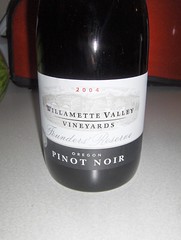 The most significant graph you're likely to see all year. Image via Wikipedia
The most significant graph you're likely to see all year. Image via Wikipedia
A commenter to the prior post mentioned Jeffrey (Westexas) Brown's "
Export Land Model," which is a very, very important concept that I think everyone needs to be familiar with.
It's actually quite easy to understand, although I think the terms used are off-putting and confusing.
In a nutshell, the ELM says that, when it comes to oil exports, the only thing that matters is NET exports (the oil that crosses the borders, rather than the oil that comes out of the ground).
As people who live in a valley with no fossil fuels in a state with no fossil fuels in a country that is rapidly exhausting its fossil fuel endowment (particularly of oil), that's pretty easy for us to understand. It's like the old investment ads touting tax-free bonds: "It's not how much you make that counts, it's how much you keep," only here it would be "It's not how much you pump, it's how much you export that counts."
In the imagination of most people, oil exporting countries are lightly populated and use little of their own oil. Reality is quite different: fueled by the wealth garnered from oil, populations are exploding in the oil-producing nations. Moreover, the per-capita oil consumption is climbing as these countries seek to attain the same comforts and conveniences of the rich, oil-importing countries.
In other words, the difference between what they pump and what they use for their own needs (the amount they can export to people like us) keeps shrinking, and it shrinks much faster than new fields can be brought on (in those few countries that still have not already peaked and entered the decline in total production).
CORRECTED PARAGRAPH:
Post-Carbon Oregon has a nice post on a related phenomenon with graphics, taken from The Oil Drum, the indispensable site for those who want to understand the major force propelling history right now. Both the declining yield curve (less oil out for each unit of energy/oil invested) and the ELM mean that we are going to be able to access a lot less oil than a straight reserves divided by annual use rates might suggest. As many people have noted over the years, peak oil is a RATE problem.
As for me, I wish the "Export Land Model" (you can Google that and Jeffrey Brown to learn how that obscure name came to be) was better understood, particularly by those in jobs where an absence of leadership has serious consequences (elected officials, planners, etc.).
I think we need a grabby name that explains the concept in the name itself: I propose that, instead of referring to the "export land model," we talk about either the
- Oil Producers' Export Contraction curve ("the OPEC curve"), or, if you prefer, the
- Oil Exports' Continuous Decline curve ("the OECD curve")
(where OPEC is, of course, the acronym for the Organization of Petroleum Exporting Countries -- the ones who are exporting a smaller and smaller share of a smaller and smaller total production each year -- and OECD are the initials of the group of rich countries that are going to be hammered by this inexorable process, the Organisation for Economic Co-Operation and Development.) Both terms make the point that, on the whole, the amount of oil flowing from the first group (exporters) to the second (importers) is going to decline even faster than the decline in the amount coming out of the ground.
And, given the centrality of oil to our lives, this means that a "return to a growth economy" is probably a fantasy from here out. What we can expect significant growth in is in the number of economic charlatans and fakirs who pretend that growth can continue without growing oil imports -- but, like Wily E. Coyote -- these characters can only suspend the laws of physics for a brief moment before they fall to the floor of the canyon far below.
 Enjoy it while it lasts. Image by pete4ducks via Flickr
Enjoy it while it lasts. Image by pete4ducks via Flickr
![Reblog this post [with Zemanta]](http://img.zemanta.com/reblog_e.png?x-id=da1df3ea-765c-4c64-b111-7e2617130f7c)

![Reblog this post [with Zemanta]](http://img.zemanta.com/reblog_e.png?x-id=e125f0f6-5ec8-487e-804d-a642b32500a5)



